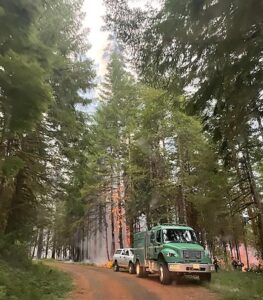
The Camp Creek Fire, currently burning perilously close to Oregon’s Bull Run watershed, underscores the need for proactive forest management. As the flames have inched closer to the watershed that serves as the primary drinking water source for the city of Portland, it becomes evident that policies prioritizing preservation over proactive mitigation may be putting the city’s water supply at severe risk.
The looming threat of wildfires in the Bull Run watershed is well-documented. The Portland Water Bureau’s 2014 Fire Management Plan suggested that given the natural fire rotation, the watershed has been due for a large scale fire. Yet the city government and its voters have doubled down on policies that make managing the watershed even more prohibitive.
One such policy, Measure 26-204, introduced in 2019 by then-Commissioner Amanda Fritz, imposed additional “protections” for the watershed’s old-growth forests and vulnerable species like the Northern spotted owl. This measure, which requires voter approval for certain forest management activities, was overwhelmingly approved. The problem is that the measure hamstrings efforts to undertake crucial fuels reduction and commercial thinning to curb wildfire risks. The old-growth forests and endangered species that were intended to be protected are now facing an existential threat, and the city’s water supply, serving hundreds of thousands, hangs in the balance.
Adding another layer of complexity, federal laws from 1996, coupled with regulations from the Northwest Forest Plan, have long prohibited commercial logging in this area of the Mt. Hood National Forest. As our forests experience the impacts of climate change, our policymakers have chosen to impose a bureaucratic maze that impedes the ability to execute proactive treatments that could have influenced the severity of the Camp Creek Fire. Such treatments, including strategic fuel breaks, could have potentially made it easier for firefighters to contain the fire before it got close to the city’s water supply.
The notion of striking a balance between environmental protection and practical resource management is not new. It is essential to recognize that forest management need not equate to reckless deforestation. Proactive treatments can include controlled burns, selective tree removal, and other measures that mimic the natural processes that once maintained the ecosystem’s health. Responsible forest management seeks to enhance resilience, mitigate fire risks, and ultimately sustain biodiversity.
While the impacts of the Camp Creek Fire on Portland’s water supply are yet to be fully realized, the specter of water quality degradation looms large. Ash, mud, and debris from the fire zone have the potential to flow into the reservoirs, increasing turbidity and compromising the city’s drinking water. A compromised water supply could have ripple effects on public health, local economies, and the overall well-being of the city’s residents.
As the city prepares to spend $2 billion on a water treatment plant, it’s also worth asking if proactive and routine forest management and maintence within the watershed would accomplish the same goals at significantly less cost to city ratepayers.
Portland residents deserve a sustainable water supply, and it is within our capacity to achieve this without sacrificing the ideals of environmental conservation. The Camp Creek Fire, fueled by excess vegetation and dead trees, and stoked by years of policy limitations, illustrates the dire consequences of overlooking the need for proactive measures that may include cutting trees.



